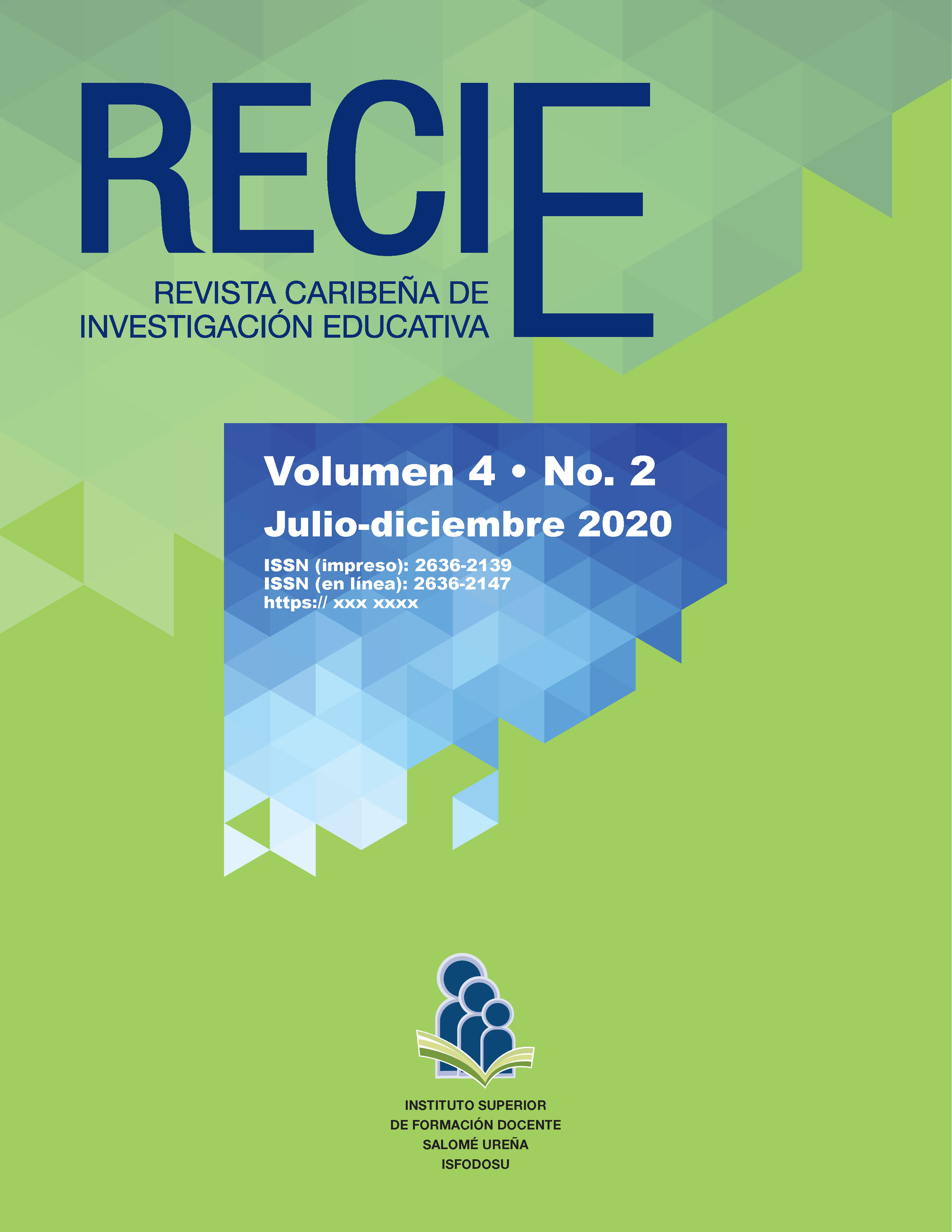Analysis of Resources for the Teaching of Early Literacy in the Light of the Dominican Curriculum
Authors
Ramón Marcelino Viñas-Marte
Artículo de Investigación
[email protected] https://orcid.org/0000-0003-2874-9083Lourdes Natalia Guzmán-Taveras
Pontificia Universidad Católica Madre y Maestra, República Dominicana
[email protected] https://orcid.org/0000-0003-4416-3824Detalles
Published
Abstract
The didactic resources used for teaching Early Grade Literacy (EGL) are tools that bring students closer reading culture, allowing them to recognize written code and its characteristics. The alignment of
pedagogical resources with what is prescribed in the teaching curriculum has positive influence on literary performance, which in the Dominican Republic, is reported as one of the region’s lowest. Due to this, there is an interest in analyzing the characteristics of the pedagogical resources in the EGL free-access database (LEIRD). A mixed study was designed with the objective of determining the alignment of said database with the current Dominican curriculum, and identifying areas of improvement. A total of 115 pedagogical resources were randomly choosen from the 485 resources in the database. The results showed that the majority of resources propose interventions in line with the teaching approaches that underpin the Dominican curriculum: the textual, functional, and communicative approach, as well as the cognitive process by competencies. It is suggested that the inclusion criteria of the resources that make up the LEI-RD
database be reviewed to ensure alignment with current evidence on the effective teaching of the LEI and the current Dominican curriculum.
Keywords
How to Cite
Downloads
Metrics
References
Azorín-Millaruelo, C., Bernal-Martínez, I., Cívico-Martín, R., Cózar-Santiago, A., Guzmán-Pérez, C., Losada-Yáñez, M., Morillo-Moreno, J., Nonó-Rius, B., Padrós-Cuxart, R., & Prats-Prat, J. (2017). Guía para la evaluación de repositorios institucionales de investigación. España: Recolecta.
Blanco, L., Cuter, M. E., Grúnfeld, D., Rodríguez, M. E., & Calmels, D. (2007). Enseñar lengua en la Escuela Primaria. Argentina: Tinta fresca Ediciones.
Charria, M., & González, A. (1992). Hacia una nueva pedagogía de la lectura, Argentina: AIQUE Educación.
National Reading Panel, National Institute of Child Health and Human Development. (2000). Report of the National Reading Panel: Teaching children to read: An evidence-based assessment of the scientific research literature on reading and its implications for reading instruction: Reports of the subgroups. National Institutes of Health. https://r.issu.edu.do/l?l=78tEP
Daviña, L. (2003). Adquisición de la Lectoescritura. Revisión crítica de métodos y teorías. Santa Fe, Argentina: Homo Sapiens.
De Lima, D., & Montenegro, L. (2010). Las guías de lectura y escritura y su importancia para la enseñanza-aprendizaje de la lengua en contextos socioeconómicos vulnerables. En D. R. ILCE (coord.), Aprendizaje efectivo de la lectoescritura (pp. 43-61). México: ILCE.
De Lima, D. (2018). Teoría de aprendizaje y práctica alfabetizadora en los primeros grados de primaria. Santo Domingo: IDEICE.
Ferreiro, E., & Teberosky, A. (1991). Los sistemas de escritura en el desarrollo del niño. Argentina: Siglo XXI editores.
Ferreiro, E. (2006). La escritura antes de la letra. CPU-e, Revista de Investigación Educativa, 3, 1-52. https://r.issu.edu.do/l?l=79aKd
Fons, M. (2004). Leer y escribir para vivir. Alfabetización inicial y uso real de la lengua escrita en la escuela. Barcelona: Editorial Graó.
Gutiérrez, F., & Díez, A. (2018). Conciencia fonológica y desarrollo evolutivo de la escritura en las primeras edades. Educación XXI, 21(1), 395-415. https://r.issu.edu.do/l?l=81y9H
Higuera Guarín (2016). De la estética de la recepción a la animación a la lectura: consideraciones teóricas para una propuesta de animación de la lectura literaria en espacios no convencionales. La Palabra, (28), 187-200. https://doi.org/10.19053/01218530.4815
Kaufman, A. (coord.) (2009). Leer y escribir: el día a día en las aulas, Buenos Aires: AIQUE Educación.
Limpo, T., & Alves, R. A. (2013). Modeling writing development: Contribution of transcription and self-regulation to Portuguese students’ text generation quality. Journal of Educational Psychology, 105(2), 401-413. https://doi.org/10.1037/a0031391
Lluch, G., & Sánchez-García, S. (2017). La promoción de la lectura: un análisis crítico de los artículos de investigación, Revista Española de Documentación Científica, 40(4), 114. http://dx.doi.org/10.3989/redc.2017.4.1450
Ministerio de Educación de Argentina. (2010). La formación docente en alfabetización inicial. https://r.issu.edu.do/l?l=82vwf
Ministerio de Educación de la República Dominicana (MINERD). (2016). Diseño curricular. Nivel Primario, Primer Ciclo. República Dominicana: Ministerio de Educación.
Ministerio de Educación de la República Dominicana (MINERD). (2017). Resultados de la evaluación diagnóstica nacional de tercer grado de primaria. Santo Domingo: MINERD.
Ministerio de Educación República de Chile. (2011). Estándares para las bibliotecas escolares CRA. https://r.issu.edu.do/l?l=83MGz
Montenegro, L. (2013). Proyecto: Revisión y actualización del currículo vigente. https://r.issu.edu.do/l?l=84s8a
Montenegro, L. (2010). El enfoque comunicativo de la enseñanza de la lengua. En Aprendizaje efectivo de la lectoescritura (pp. 43-61). México: ILCE.
Ortiz, D., & Robino, A. (2003). Cómo se aprende, cómo se enseña la lengua escrita. Buenos Aires: Lugar Editorial.
Rasinski, T. (2010). The Fluent Reader. New York: Scholastic.
Romero, L. (2014). El aprendizaje de la lectoescritura. Nicaragua: Fe y Alegría.
Rosemberg, C., Menti, A., Stein, A., Alam, F., & Migdalek, M. (2016). Vocabulario, narración y argumentación en los primeros años de la infancia y la niñez. Revista Costarricense de Psicología, 35(2), 139158. https://r.issu.edu.do/l?l=224lq1
Shanahann, T. (2005). The National Reading Panel Report: Practical Advice for teachers. Chicago: Learning Point Associates.
Stone, R. (2019). Lectoescritura inicial en América Latina y el Caribe: una revisión sistemática. Revista de Investigación y Evaluación Educativa, 6(1), 22-36. https://r.issu.edu.do/l?l=86Vge
Teberosky, A. (2000, diciembre). Los sistemas de escritura. Trabajo presentado en Cong reso Mundial de Lectoescritura, Universidad de Barcelona, Barcelona.
Vijil, J. (2019). Actores clave en lectoescritura inicial en República Dominicana. Resultados de un mapeo y análisis de actores. Revista de Investigación y Evaluación Educativa, 6, 38-49.
Yepes, L. B., Caretta, M. G., & Díez, C. (2013). Jóvenes lectores. Caminos de Formación. Montevideo, Uruguay: Ministerio de Educación y Cultura.
Section
License
Copyright (c) 2020 Caribbean Educational Research Journal (RECIE)

This work is licensed under a Creative Commons Attribution-NonCommercial-NoDerivatives 4.0 International License.
